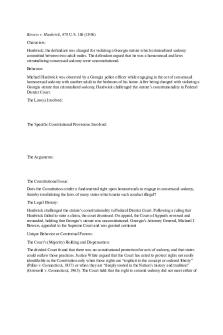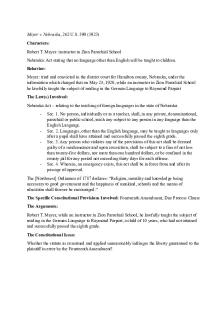Brandenburg v - Lecture notes case brief PDF

| Title | Brandenburg v - Lecture notes case brief |
|---|---|
| Author | Jozie Lowe |
| Course | Constit Law Ii/Civil Liberties |
| Institution | University of The Incarnate Word |
| Pages | 2 |
| File Size | 93.6 KB |
| File Type | |
| Total Downloads | 48 |
| Total Views | 203 |
Summary
professor metroka...
Description
Brandenburg v. Ohio 395 U.S. 444 (1969) Characters: The defendant was the leader of the Ku Klux Klan group of Ohio. He telephoned a TV station and invited a reporter to attend a rally with a camera man. Portions of the film were later broadcast showing 12 hooded figures, some with guns, gathered around a large wooden cross that was burnt. Most of the words were garbled, but scattered phrases were understood as derogatory toward African Americans and Jews. The defendant was seen making a speech conditioning future action on the acts of executive, legislative and judicial branches of the government. Behavior: Convicted under the Ohio criminal syndicalism law. The law made illegal advocating “crime, sabotage, violence, or unlawful methods of terrorism as a means of accomplishing industrial or political reform,” as well as assembling “with any society, group, or assemblage of persons formed to teach or advocate the doctrines of criminal syndicalism.” The Law(s) Involved: Ohio Criminal Syndicalism Statute, Whitney v. California (1927), Dennis v. United States (1951), Noto v. United States (1961), Schenck v. United States, Gitlow v. New York, The Specific Constitutional Provisions: First and Fourteenth Amendments, The Arguments: The Constitutional Issue: Whether Ohio’s statute can punish advocacy without defining or distinguishing advocacy that involves incitement to imminent lawless action? The Legal History: Brandenburg appealed his conviction, citing violations of the First and Fourteenth Amendments. Ohio’s intermediate appellate court and Supreme Court affirmed without opinion. The U.S. Supreme Court agreed to hear the case. Unique Behavior or Contextual Factors: The Court’s (Majority) Holding and Dispensation: The statute punishes mere advocacy and forbids assembly with others who merely advocate the type of action in violation of 1st and 14th Amendments. -
The court’s Per Curiam opinion held that the Ohio law violated Brandenburg’s right to free speech. The Court used a two-pronged test to evaluate speech acts: o (1) speech can be prohibited if it is “directed at inciting or producing imminent lawless action” and o (2) it is likely to incite or produce such action.”
-
The criminal syndicalism act made illegal the advocacy and teaching of doctrines while ignoring whether or not that advocacy and teaching would actually incite imminent lawless action. The failure to make this distinction rendered the law overly broad and in violation of the Constitution.
The Court’s Expressed Reasoning (The Majority Opinion): There is a marked difference between mere advocacy (which is protected speech) and inciting people immediately to commit violence (which is not protected speech). Ohio’s Criminal Syndicalism statute does make that distinction. Indeed, Ohio’s statute criminalizes mere advocacy as well as incitement and, therefore, violates the First and Fourteenth Amendments. Concurring and Dissenting Opinions: -
Justice Douglas o Notes that Justice Holmes’s “clear and present danger” test has rightfully fallen out of favor because it prohibited speech that should have been protected. Douglas concludes that the classic example of ‘shouting fire in a crowded theater’ is the only instance where speech may be prohibited. That is because it is “speech brigaded with action.”
Personal Notes: Brandenburg v. Ohio is a landmark First Amendment decision because it establishes the “imminent lawless action” test, also known as the Brandenburg test. It remains the standard for courts analyzing government attempts to punish inflammatory speech....
Similar Free PDFs

Brandenburg V. Ohio (T1)
- 1 Pages

Lubitz v Wells Case Brief Notes
- 2 Pages

Wesson v. Walmart - case brief
- 2 Pages

Morse v Frederick Case Brief
- 2 Pages

Graham v Connor - Case Brief
- 1 Pages
Popular Institutions
- Tinajero National High School - Annex
- Politeknik Caltex Riau
- Yokohama City University
- SGT University
- University of Al-Qadisiyah
- Divine Word College of Vigan
- Techniek College Rotterdam
- Universidade de Santiago
- Universiti Teknologi MARA Cawangan Johor Kampus Pasir Gudang
- Poltekkes Kemenkes Yogyakarta
- Baguio City National High School
- Colegio san marcos
- preparatoria uno
- Centro de Bachillerato Tecnológico Industrial y de Servicios No. 107
- Dalian Maritime University
- Quang Trung Secondary School
- Colegio Tecnológico en Informática
- Corporación Regional de Educación Superior
- Grupo CEDVA
- Dar Al Uloom University
- Centro de Estudios Preuniversitarios de la Universidad Nacional de Ingeniería
- 上智大学
- Aakash International School, Nuna Majara
- San Felipe Neri Catholic School
- Kang Chiao International School - New Taipei City
- Misamis Occidental National High School
- Institución Educativa Escuela Normal Juan Ladrilleros
- Kolehiyo ng Pantukan
- Batanes State College
- Instituto Continental
- Sekolah Menengah Kejuruan Kesehatan Kaltara (Tarakan)
- Colegio de La Inmaculada Concepcion - Cebu










